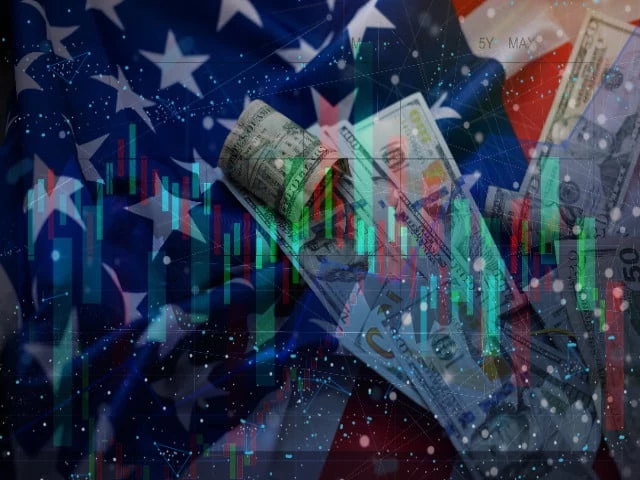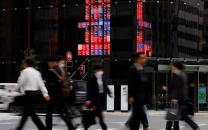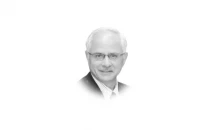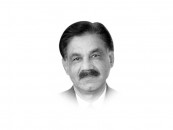Whither US economy
Growth projected to cool that reflects impact of higher tariffs, weak labour market

The US economy, though still resilient, is showing unmistakable signs of fatigue. After two years of surprisingly strong expansion, growth is now projected to cool to around 1.6-1.8% in 2025, according to the Organisation for Economic Co-operation and Development (OECD) and several private forecasts. The slowdown reflects the combined impact of higher tariffs, elevated borrowing costs, and a labour market gradually losing steam – even as the country's vast technological engine continues to power selective pockets of strength.
The latest data from the US Bureau of Economic Analysis shows a tale of two quarters. Economic output fell modestly in the first three months of 2025, pulled down by weak government spending and a drag from imports. But the second quarter rebounded sharply, posting a 3% annualised gain. The recovery was driven largely by consumption and a surprising revival in service-sector demand. Yet analysts caution that the underlying momentum remains uneven, with real domestic demand rising by only about 1%.
That pattern of quarter-to-quarter volatility captures the mood of 2025. The American economy is no longer surging but oscillating – alternatively lifted by innovation and held back by policy uncertainty. Most major forecasters, from Deloitte to the Philadelphia Fed's Survey of Professional Forecasters, now converge around the same conclusion: modest growth, moderate inflation, and rising unemployment over the next 12 months.
Consumer spending remains the backbone of expansion. Despite elevated prices, Americans have kept shopping and travelling, using the cushion of pandemic-era savings and rising nominal wages. But cracks are appearing. The OECD expects headline inflation to stay near 4% by the end of 2025 as tariffs raise import costs. Real wage gains are being eroded, and delinquency rates on credit cards and auto loans are climbing. Deloitte notes that household balance sheets are weakening fastest among lower-income groups – a signal that the consumption engine may lose torque in the coming quarters.
The labour market, once the pride of the post-pandemic recovery, is softening. Monthly job creation has slowed to around 140,000, unemployment is edging towards 4.4%, and labour force participation has dipped. Wage growth, while still positive, no longer outpaces inflation. Federal Reserve Chair Jerome Powell recently told reporters that "hiring has slowed notably" and hinted that the central bank will continue to calibrate policy "meeting by meeting." Translation: rate cuts are coming, but cautiously. Investors now expect one or two modest reductions before year-end, sufficient to ease credit stress without reigniting price pressures.
Even with easier money, business investment will determine whether the economy glides or grinds lower. Here lies the most interesting story of 2025. An investment boom in artificial intelligence, cloud computing, and advanced manufacturing is cushioning the downturn.
The IMF and private forecasters describe this as the "AI buffer" – an offsetting wave of capital expenditure that sustains productivity even when consumer demand cools. Orders for high-tech equipment and software licences continue to rise, while intellectual property investment has become a key contributor to GDP growth. Yet outside technology, investment is patchy. Construction spending is weak, and smaller firms remain hesitant amid uncertain trade and tax policies. High long-term interest rates also limit enthusiasm for leveraged projects.
Trade policy has emerged as the clearest drag. The effective tariff rate on imports has risen to nearly 20%, the highest in almost a century. The protectionist turn, initially justified on national security grounds, is now feeding through higher consumer prices and lower corporate margins. The OECD warns that these tariffs will shave at least half a percentage point from US growth in 2025 and invite retaliation abroad. Some of the impact was delayed because firms rushed to import goods before the latest hikes – a front-loading that briefly inflated activity in late 2024. That temporary cushion is gone. Import volumes are falling, export competitiveness is weakening, and the overall trade balance is again widening.
Against this backdrop, policy uncertainty looms large. The US government shutdown, divisive budget negotiations, and unpredictable executive actions all weigh on business confidence. Fiscal policy is constrained by a record federal debt exceeding 120% of GDP. Even if Congress approves targeted infrastructure or defence spending, the cumulative fiscal impulse will remain modest.
The bigger question is political: whether Washington can deliver consistent, credible economic management at a time of global turbulence and electoral polarisation.
Most forecasts for 2025-26 paint a narrow corridor of possibilities. The base case – growth of around 1.6% this year and 1.5% next – assumes steady consumer demand, mild policy easing, and no major shocks. The upside scenario, favoured by optimists such as Vanguard, envisions that the AI investment boom and a quicker disinflation could push growth closer to 2%. The downside scenario is easier to imagine: prolonged tariff escalation, sharper labour market deterioration, or an external shock could pull the economy below 1%, flirting with recession. Several investment houses now assign a 30-40% probability to that outcome.
For the rest of the world, the stakes are high. The United States remains both the consumer and investor of last resort; a slowdown there transmits quickly through trade and financial channels. Emerging markets already face higher borrowing costs because of elevated US yields. Any prolonged weakness in American demand would reduce export revenues and capital inflows across Asia and Latin America.
The comparison with earlier episodes is instructive. In the 1980s, US growth slowed after the Reagan boom as fiscal deficits collided with higher interest rates. Yet the country escaped stagnation by reinventing its production base and absorbing new technologies – a pattern that may repeat today. The current AI-driven reinvestment cycle could, in time, yield a similar productivity dividend. But such transitions are never painless. The same digital revolution that lifts efficiency can also displace workers, deepen inequality, and test the social contract.
In that sense, 2025 is a hinge year: the moment when the US decides whether to treat technology as a bridge to inclusive growth or as a private moat for capital. For now, the numbers suggest stability, not euphoria – a gentle deceleration cushioned by innovation but constrained by politics. Growth around 2% is respectable for a mature economy; what matters is its quality and distribution.
The immediate challenge for policymakers is to preserve confidence while correcting course. Overuse of tariffs will backfire, over-tightening of credit will choke investment, and over-reliance on consumer resilience will prove short-lived. A pragmatic mix of targeted fiscal support, steady monetary easing, and credible trade diplomacy could yet keep the economy on an even keel.
America has navigated bigger storms before. Its vitality lies in adaptation – from industrial age to information age, from bricks to bytes. Whether the current slowdown becomes a pause before another leap forward or the start of a longer stagnation will depend less on the Federal Reserve's next move and more on how wisely the nation balances protection with openness, and innovation with inclusion.
The writer is a Mechanical Engineer and is pursuing Master's degree



















COMMENTS
Comments are moderated and generally will be posted if they are on-topic and not abusive.
For more information, please see our Comments FAQ